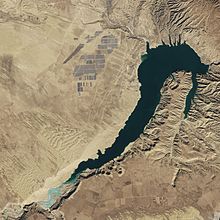


Hydroelectricity is currently China's largest renewable energy source and the second overall after coal.[1] According to the International Hydropower Association, China is the worlds largest producer of hydroelectricity as of 2021.[2] China's installed hydroelectric capacity in 2021 was 390.9 GW, including 36.4 GW of pumped storage hydroelectricity capacity, up from 233 GW in 2011. [3][4] That year, hydropower generated 1,300 TWh of power, [5] an increase of 68 TWh over 2018 when hydropower generated 1,232 TWh of power, accounting for roughly 18% of China's total electricity generation.[6][7][8]
China's installed hydroelectric capacity in 2024 was 426 GW [9]
Due to China's insufficient reserves of fossil fuels and the government's preference for energy independence, hydropower plays a big part in the energy policy of the country. China's potential hydropower capacity is estimated at up to 400 GW.[10] There is therefore considerable potential for further hydro development.[1]
As of 2015, hydroelectric plants in China had a relatively low productivity with an average capacity factor of 31%, due to seasonal variability of rainfall, rapid construction, and significant energy loss due to need for long transmission lines to connect remote dams in the mountainous south-west to demand in southern China.[1]
Although hydroelectricity represents the largest renewable and low greenhouse gas emissions energy source in the country, the social and environmental impact of dam construction in China has been large, with millions of people forced to relocate and large scale damage to the environment.[11]
- ^ a b c Walker, Qin (29 July 2015). "The Hidden Costs of China's Shift to Hydropower". The Diplomat. Retrieved 1 November 2016.
- ^ "Hydropower Status Report – Sector Trends and Insights" (PDF). International Hydropower Association. 2021. Retrieved April 22, 2022.
- ^ "2021 Hydropower Status Report" (PDF). assets-global.website-files.com. Retrieved 12 October 2023.
- ^ "Country Rankings". /Statistics/View-Data-by-Topic/Capacity-and-Generation/Country-Rankings. Retrieved 2021-03-12.
- ^ "Statistical Review of World Energy 2022" (PDF). BP. Retrieved 12 October 2023.
- ^ "Country Rankings". /Statistics/View-Data-by-Topic/Capacity-and-Generation/Country-Rankings. Retrieved 2021-03-12.
- ^ "China | International Hydropower Association". www.hydropower.org. Retrieved 1 November 2016.
- ^ "2018 electricity & other energy statistics". China Energy Portal | 中国能源门户. 2019-01-25. Retrieved 2021-03-12.
- ^ "2024 World Hydropower Outlook". International Hydropower Association. 2024. p. 89. Retrieved September 20, 2024.
- ^ "Renewable Energy Prospects: China". International Renewable Energy Agency. November 2014.
- ^ Hvistendahl, Mara. "China's Three Gorges Dam: An Environmental Catastrophe?". Scientific American. Retrieved 1 November 2016.